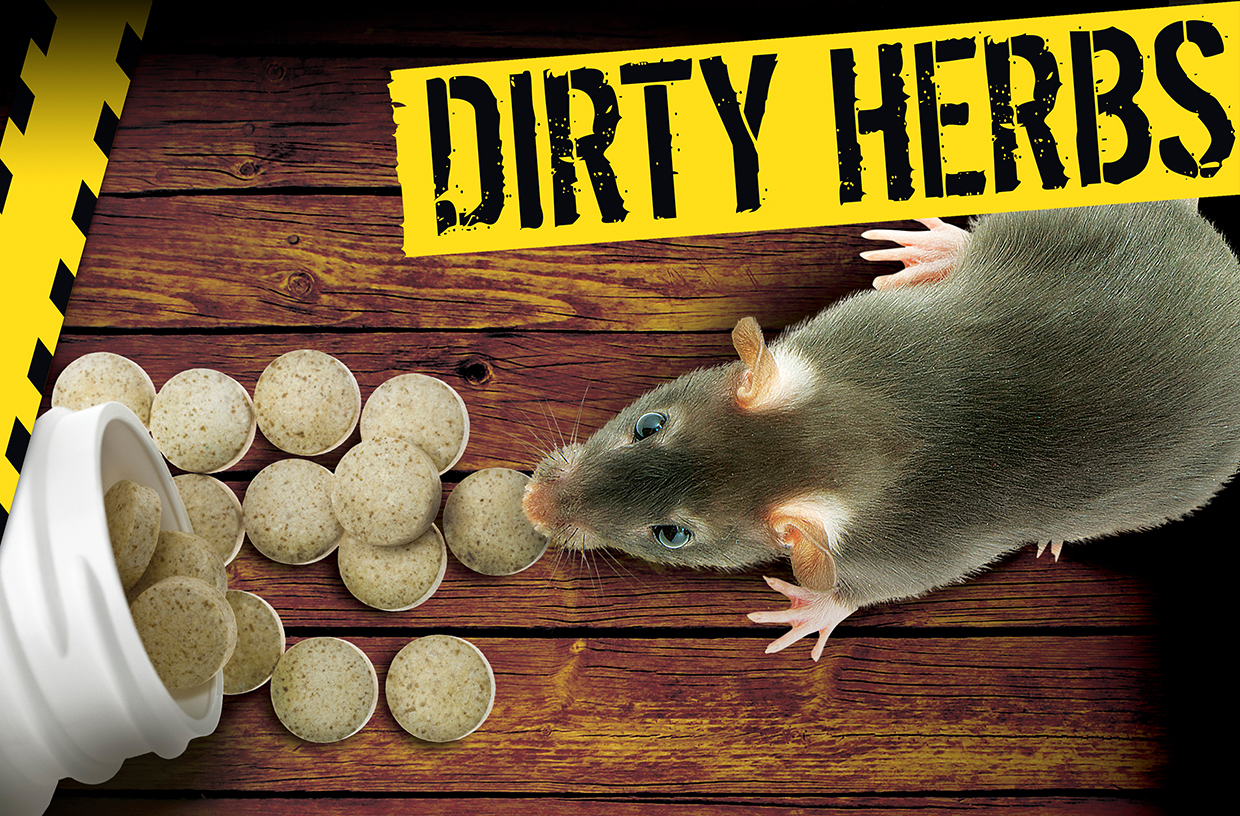Dirty Herbs

The Shocking Truth Behind the Closed Doors of Supplement Companies in Asia
In June 2012, I gave a seminar at the International Society of Sports Nutrition (ISSN) discussing dietary supplements, alternative medicine and complimentary health products. I also talked about regulatory confusion and, in some cases, sheer avoidance of the applicable regulations regarding the production and storage of the raw ingredients that make up these finished goods.
Part of the issue for us on the marketing and manufacturing side—at least in the United States—is a lack of harmonization between the rules that govern the producers and handlers of the raw ingredients (governed under 21 CFR 110) and those who produce and handle the finished products sold to consumers (governed under 21 CFR 111). While readers are unlikely to be of the same audience who sat in on my lecture, and may be bored to death by a side-by-side comparison of the different parts of the Code of Federal Regulations, many of the issues I discussed during that lecture are of serious importance to anyone who buys and consumes these types of products.

QUESTIONABLE SOURCES
Think about the pre-workout powder or the herbal testosterone-boosting capsules you buy in the local health-food store and online. Have you ever wondered where they came from and who made them? What are the rules for manufacturing and are they even followed? Are mistakes made? Are they allowed? Where do the raw materials come from? Where does it all begin? In most—but not all—cases, the raw materials are likely to originate from India or China. Consider the following:
• From January 2012 to April 2012 China exported more than 34,000 metric tons of Vitamin C and its derivatives as well as about 200,000 tons of citric acid to the United States (Source: Hong Kong Trade Development website).
• Exports of herbal products from India to the United States and Europe are expected to exceed 120 billion rupees (US$2.28 billion) by the end of 2012 (Source: Silicon India News website).
• India dominates the world market in production and export of psyllium husk and seeds. India exports 80 percent of the psyllium available in the world market. The United States is the world’s largest importer of psyllium husk with over 60 percent of total imports (Source: SME World website).
• As of 2009, more than 500 different Chinese herbs were imported into the United States, and the annual output of herbal materials exported from China exceeded 600 million kilograms (Source: Articlebase.com website).
• China has evolved into the world’s largest supplier of bulk drug or APIs (active pharmaceutical ingredients) required for pharmaceutical products and dietary supplements. Despite the current economic downturn, this expansion will continue. China has surpassed the U.S. to become the largest bulk drug manufacturing and exporter in the world.

| As of 2008, a breakdown of some of the raw materials imported into the USA from China looked like this: |
|---|
|
6.20% of import totals were amino acids |
|
17.8 % of import totals were vitamins |
|
1.41% of import totals were herbal extracts & alkaloids |
|
The Top 10 Leading Chinese Exporting Companies sold |
|
The Top 25 Leading Chinese Exporting Companies |

Clearly, India and China supply a large portion of the raw materials used to produce dietary supplements and natural health products. In China, the CSFDA (Chinese State Food & Drug Administration) has regulatory oversight of how materials are produced and under what conditions they are used for in medicines and food products. In India, it’s a little more convoluted right now as no less than five governmental agencies have some jurisdiction (and separate sets of rules) for these types of ingredients. Because of this complexity, and I would argue, the frustrating situation in India, I will leave that country for a separate article and focus on China.
 CHINESE OVERSIGHT
CHINESE OVERSIGHT
I have visited China close to two dozen times since 2003. The CSFDA has, in recent years, done a lot to increase the safety and harmonization of raw materials produced in China that go into foods and natural health products around the world. Sure there have been some scandals—for example, the melamine adulteration issues in dog food and baby formula. But the Chinese government has been very swift to act on these instances and bring those guilty of fraudulent adulteration to quick justice from the local level all the way to Beijing. They are not tolerating it anymore, and I applaud them for their continuing and vigilant efforts to ensure a safer and more regulated food and natural products raw material industry both in China and around the world.
But this doesn’t mean that the businesspeople running these companies in China aren’t negligent. Some do not know and understand these laws or the recent changes to them, and many are out to make a fast buck by committing outright fraud. These situations are not unique to China and can actually happen in the United States, Canada and elsewhere in the west. There will always be those who make mistakes and those who cheat.

UNSANITARY, UNCERTAIN, UNSAFE
I’ve been to factories and plants in China that produce raw materials where the facilities rival the best of those found in Germany or the United States. I’ve also seen facilities in China producing the same raw materials in conditions that aren’t acceptable to the FDA in the United States, the NHPD in Canada, or the CSFDA in China. Many of these “unacceptable” facilities aren’t producing products for use in foodstuffs in the first place and, with the Internet and international trade sites such as Alibaba and Made-In-China.com, it’s very easy for anyone with a credit card to order anything produced in China (or elsewhere) and have it airlifted to them in a matter of days or weeks without ever leaving the comforts of their home or the office.
Consider the following: If I mention the word “caseinate,” most people reading this would logically think, “protein supplement.” However, it might come to a surprise to many of you that caseinates are used to produce other items such as plastics, paints, fabrics and the tips of matches. If I say “waxy maize starch,” most would think, “post workout carb source.” Did you know that waxy maize starches are also used to make paper, corrugated cardboard, paste and the adhesive that is found on the sticky side of tape products? How about “amino acids?” Yes, they have their place in sports nutrition and performance enhancement, but they also have an equally important place in making polyester, polyurethane, disposable baby diapers, plastics and corrosions inhibitors (and the list of industrial uses goes on and on). Whether used for food or industrial applications, all of these products/ingredients are made and can be sourced from China.

TRICKY REGULATIONS
And therein lie some of the potential problems. The “non-food” grade ingredients are usually more affordable to purchase because the conditions under which they are produced are less stringent and regulated differently than food industries—if they’re regulated at all! A Chinese chemical company making amino acids for use in the polyester or textile industries isn’t likely to be regulated nor inspected by the CSFDA. Why would they? However, if an American or Canadian company were looking to purchase amino acids from China, they might opt to buy from such a Chinese company based on price, which is likely to be a lot lower. If the American or Canadian company has never been to China and audited the facility, it would never know that the manner in which these amino acids are produced would not be acceptable to the NHPD, the FDA, or even the CSFDA!
This is why it’s critically important (and in the US, a matter of cGMP/law) for producers of finished products meant for human consumption (e.g., dietary supplements, natural health products) to visit the facilities that actually produce the raw materials they use to put into their finished goods. As the global economy limps along and unemployment rates remain high in the US, the EU and Canada, people are looking for ways to save money in all aspects of their lives. Maybe you have considered switching to a lower cost dietary supplement or natural health product? After all, the industry is “regulated,” right? Just remember: Sometimes you get what you pay for, and that “good deal” on whatever product you’re purchasing might contain ingredients that were made in factories that have never been inspected by anyone and may be … shall we say … a bit on the “dirty” side?

BUY SAFE, BUY RIGHT
So what can you as a consumer do to protect yourself? First, recognize there is a relationship between quality and price. While a high-priced good does not always equate to a quality product with quality ingredients, it’s much more difficult for bargain basement-priced products to use quality ingredients. Also, patronize brands that you trust because they have passed inspection by governmental regulatory agencies where you live and haven’t been cited for any gross violations that put the general public at risk. A company that has been publicly cited for serious health violations or hygienic/sanitation problems isn’t likely to put much thought into where or how the raw ingredients that go into producing its finished products are made.
REFERENCES
Source: US & China Economic Security and Review Commission Report by NSD Bio Group LLC - April 2010
Click HERE to sign up for our free newsletter!

